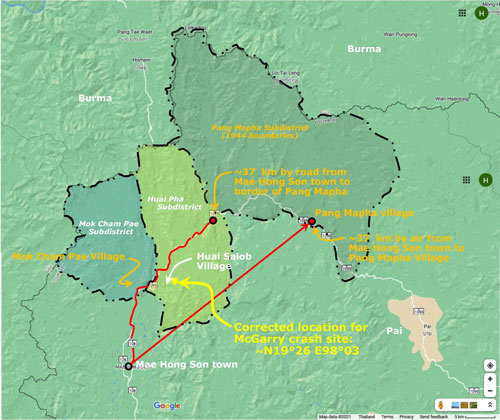| Details of Aircraft Losses by Date 24 Mar 1942: McGarry at Mae Hong Son |
| Text | Notes | ||||||||||||||||||||||||||||||||||||||||||
|
24 Mar 1942: William McGarry was a pilot assigned to the Flying Tigers, more properly, the American Volunteer Group (AVG). He flew in the 1st Squadron (nicknamed the "Adam and Eves"):[1]
On this date, having earlier flown out of Kunming, Yunnan, to Loiwing, and then on to RAF airstrip in Namsang, Burma . . .[1α]
. . . he was one of ten Flying Tigers to attack Japanese-held airfields in northwest Thailand. His group of six P-40s was to strafe Chiang Mai Airport. Flying as "top cover", his plane was hit by anti-aircraft fire from the airport. McGarry successfully nursed his plane about 125 km northwest into Mae Hong Son Province where he had to finally bail out. After 28 days[1a] on the run, he was captured by Thai police. Following an interrogation by Col Tateo Kato, commanding the 64th Sentai located in Chiang Mai, McGarry was sent to a Bangkok jail where he languished for three years.[2] On 14 April 1945, he was smuggled out of Thailand at the specific request of Gen Claire Chennault, who had been his commander in the AVG in 1942.[3] Crash site: Discovery of wreckage that was most probably McGarry's P-40 was first recorded in a telegram from Mae Hong Son dated 10 April 1944 which located the crash site in Tambon Pang Mapha, about 23 km ENE of the actual site as later determined;[4] the detail in the report strongly implies that the wreckage was indeed that of McGarry's P-40, but wrongly located. No record has surfaced to date of any action taken as a result of the message. Nor has any aircraft wreckage ever been found in Pang Mapha. In 1991, "tribal hunters" found aircraft wreckage north of Mae Hong Son town:[5]
Tango Squadron Museum Chiang Mai investigated and confirmed that the wreckage was that of McGarry's P-40. That it took almost 50 years to be rediscovered suggests the remoteness of the site. The wreckage was retrieved in June 1991:[6]
And it is now on display at a Tango hangar in Chiang Mai Airport:[7]
In 1998, Muang Mae Hong Son sought assistance in investigating an aircraft crash site vaguely located somewhere in or near Tambon Huai Pha.[8] Numberous interviews conducted in the area concluded that the report simply recycled information about the McGarry site discovered in 1991.[9]
An independent research group around 1999 visited the crash site and claimed to have found wreckage.[13] Summary of reported locations for McGarry's P-40 wreckage:[14]
In the map above, previous locations, "Pang Mapha" reported in 1944 and "Mok Cham Pae" recorded in 1991, are shown in tan. The correct location is shown in yellow. Afterword: Following the war, McGarry earned a law degree and thereafter practiced law with the US military to his retirement. He died on 13 April 1990 of cancer in Loma Linda, California.[15] The wreckage of his P-40 was discovered about a year after his death. References (listed chronologically by publication date): • Ford, 1991:[16]
• Shores, 1993:[17]
• Umemoto, 2002:[18]
Umemoto comment (translated):[19]
|
Readers are encouraged to copy this webpage for their own future reference. See How to Copy Webpages. These pages were composed to be viewed best with Google Chrome. 1.^ Photo from Tango Squadron Air Museum by "Starling" who does not source the photo.
1α.^ Map extracted from Google Maps; annotations entered with Microsoft Publisher by author.
1a.^ Bob Bergin records'"three weeks" [per TimL (Tim Landers) in forum on flyingtigersavg.com, posted 01-29-2004 01:16PM (forum blog not now accessible). [my ref: 02313 1095 192 McGarry crash site:flyingtigersavg.txt]]. Whichever duration, avgbob in same forum, 01-18-2006 11:28AM, records "He said he ate everything and drank the water. He felt that he would get sick, but he would have immunity after that. I guess it worked." 2.^ Ford, Dan, Flying Tigers (Washington: Smithsonian, 1991, 2007), pp 244-245. Note that Umemoto records Kato as only reviewing the results of the interrogation later in Bangkok (see References "Umemoto comment" below). 3.^ Bob Bergin, "The Exfiltration of Mac McGarry", posted June 2016. 4.^ Sakpinit Promthep email of 23:22 22 Nov 19, att "19440410-1 front.jpg" 5.^ Ref needed for "tribal hunters". Photo: Sakpinit Promthep email of 23:22 22 Nov 19, att "P-40 19420324 McGarry.jpg"
6.^ Line message from RTAF Mjr Veerachad to Wiyada Kantarod 22 Feb 2020, att 1582442349565.jpg.
7.^ Thai Aviation: Flying Tigers Curtis P-40 Curtis P-40 crash remains. ["Curtis" should be "Curtiss"] 8.^ Sakpinit Promthep email of 01:19 01 Sep 20, att "19980519-01.jpg" et al, Mae Hong Son City Hall to [Tango], Subject: Assistance requested to inspect aircraft wreckage (translation) 9.^ Various interviews conducted by Wiyada Kantarod and Hak Hakanson between 08 Feb 2020 and 05 Apr 2021. 10.^ See photo, 1582442349565.jpg, above, with superimposed title "Mok Jum Bare". This is a transliteration of the Thai, หมอกจำแป่. Mok Jum Bare is rendered by RTSD Map 4547 I "Chungwat Mae Hong Son" (1976 data), as Mok Cham Pae or Mok Champae. and is therefore the official version of the place name. Regardless, Tango's transliteration provides the more accurate Thai pronunciation. 11.^ Interviewed by Wiyada Kantarod and Hak Hakanson on 06 Apr 2021 in Huai Salob. Photo, by author, aIMG_20210406_134543.jpg extract. 12.^ Discussed at a meeting of "Founding Committee of the Friends of Tango Air Museum Club" on 02 Jul 2020. 12a.^ There is also the possibility that Tango was intentional in wrongly locating the site so as to discourage souvenir hunters. 13.^ Sakpinit Promthep email of 01:19 01 Sep 20, att "19980519-01.jpg", Mae Hong Son City Hall to [Tango], Subject: Assistance requested to inspect aircraft wreckage (translation), cover letter. The research group mentioned was probably หัางหุ้นส่วนจํากัดเฌอกรีน, Green Tree, LLP, Ltd, which produced รายงาน การ สําร จอขุดค้น ตาม โครงการ คึกษาเชิงอนรักษ์แหล่งฝังศพทหารญี่บุน สมัย สงครามโลกครั้งที่2 จังหวัดแม่ฮ่องสอน, Report on Archaeological Research For the Japanese Soldiers Burial Project World War II Era - Mae Hong Son Province (Chiang Mai: Archaeology & National Museum Office 6, 1999) 14.^ Google Map of area annotated with Microsoft Publisher by author.
15.^ Arcado Nickii Wantakan, Finding Freedom.
16.^ Ford, ibid, pp 245-247.
16a.^ "I have a personal feeling for "Black Max" McGarry, as he lived here in Desert Hot Springs. I helped him on his needs until he died. He told me some interesting stories. As for his bailout over Chiang Mai, he never saw any note, that was supposed to have been dropped to him . . . ." --- tigergroupie in forum on flyingtigersavg.com, posted 09-10-2002 04:24PM (forum blog not now accessible). [my ref: 02313 1095 192 McGarry crash site:flyingtigersavg.txt] 17.^ Shores, Christopher and Brian Cull with Yasuho Izawa, Bloody Shambles, Vol Two (London: Grub Street, 1993), pp 356-357.
18.^ 梅本弘 [Umemoto, Hiroshi], ビルマ航空戦・上
19.^ Umemoto, ibid,
|
||||||||||||||||||||||||||||||||||||||||||
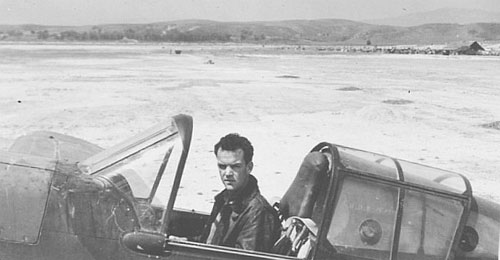
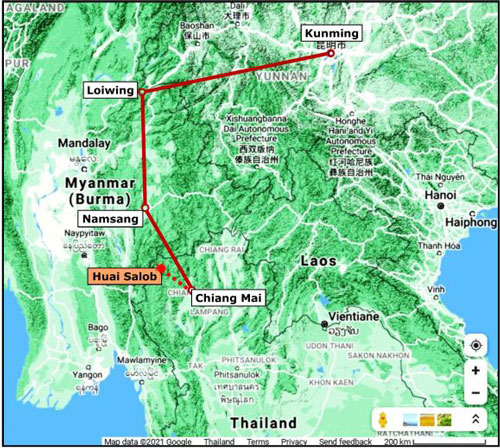
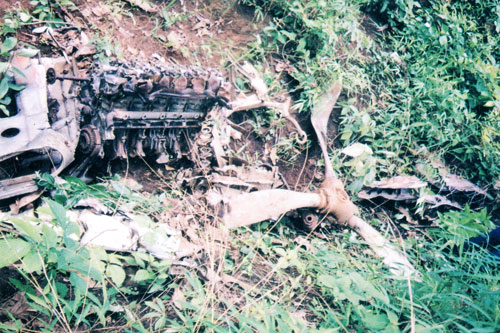
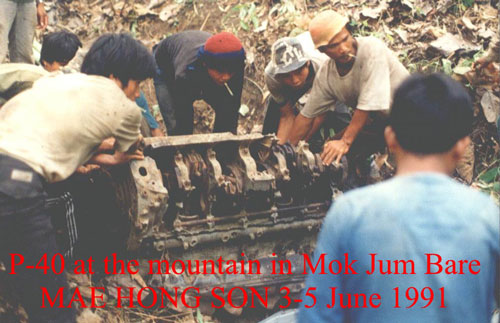
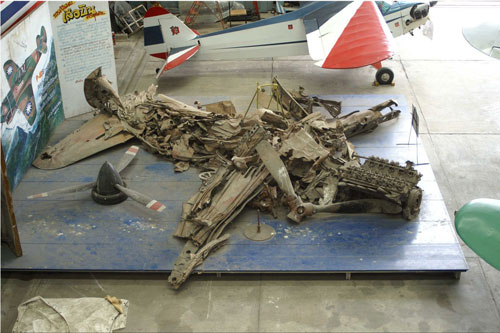
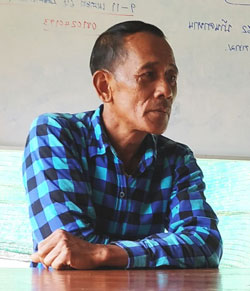 The location of the crash site for McGarry's P-40 was originally recorded by Tango as Mok Cham Pae.
The location of the crash site for McGarry's P-40 was originally recorded by Tango as Mok Cham Pae.